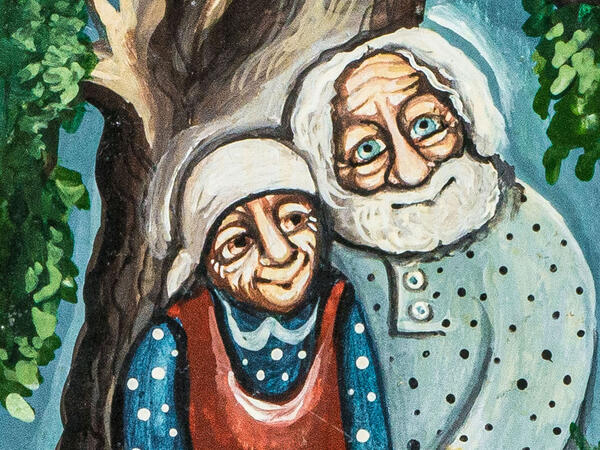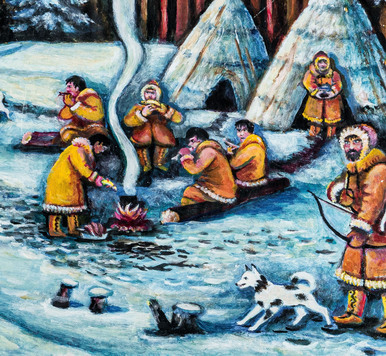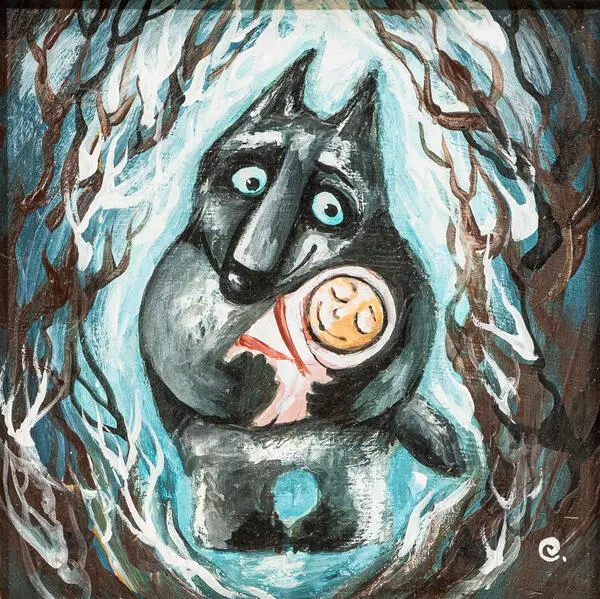Elena Sitnikova’s reflections on happiness are captured in the painting miniature of the same name. The artist treats this state in her own way and conveys it through specific ideas and images. For a naive artist, happiness means living in love until the old age, being close to a loved one and holding this person’s hand.
In the painting, Sitnikova depicted an elderly couple on a hot summer day. They sit on a bench under a towering tree. The old man and the old woman sit close to each other. The artist depicted a lot of details that indicate the spiritual unity of these characters. For example, the toes of their shoes are turned to each other.
The man and woman in the picture even look alike. Sitnikova depicted them as stocky people, with robust figures, large eyes and noses, and kind smiles. In this way she emphasized the widespread idea that spouses who have lived together for a long time become similar to each other. But at the same time, Sitnikova left individual features: the old man has bright blue eyes, and the old woman has brown ones.
The artist emphasizes the integrity of the images, their unity and difference at the same time with the help of the color scheme in clothing. The woman’s dark blue blouse with white polka dots and a collar contrasts with the man’s pale blue shirt and complements it.
The idyllic life of villages in the ‘village that never exists anywhere’ became the main theme of Elena Sitnikova’s paintings. As a child, the artist spent every summer in the village with her grandmother. Today, with the help of art, she is trying to return these carefree days and recreate them in paintings.
The search for the lost paradise, the motif of returning to childhood and youth is often repeated in the works of naive artists. This is the name for non-professional painters. They often intentionally or intuitively violate the formal rules of fine art, but their works are distinguished by their originality and high quality.
In the painting, Sitnikova depicted an elderly couple on a hot summer day. They sit on a bench under a towering tree. The old man and the old woman sit close to each other. The artist depicted a lot of details that indicate the spiritual unity of these characters. For example, the toes of their shoes are turned to each other.
The man and woman in the picture even look alike. Sitnikova depicted them as stocky people, with robust figures, large eyes and noses, and kind smiles. In this way she emphasized the widespread idea that spouses who have lived together for a long time become similar to each other. But at the same time, Sitnikova left individual features: the old man has bright blue eyes, and the old woman has brown ones.
The artist emphasizes the integrity of the images, their unity and difference at the same time with the help of the color scheme in clothing. The woman’s dark blue blouse with white polka dots and a collar contrasts with the man’s pale blue shirt and complements it.
The idyllic life of villages in the ‘village that never exists anywhere’ became the main theme of Elena Sitnikova’s paintings. As a child, the artist spent every summer in the village with her grandmother. Today, with the help of art, she is trying to return these carefree days and recreate them in paintings.
The search for the lost paradise, the motif of returning to childhood and youth is often repeated in the works of naive artists. This is the name for non-professional painters. They often intentionally or intuitively violate the formal rules of fine art, but their works are distinguished by their originality and high quality.
Amateur artist Elena Sitnikova was born in 1959 in Nizhny Tagil. Since childhood, she was fond of drawing, after school, she entered the Ural State Technical University, but she dropped out of her studies in the third year. When Sitnikova worked as a geologist, she often drew geological maps, and then ran an art studio in the children’s club ‘Youth’ and studied at the Pavel Khozhatelev evening art school for adults.





